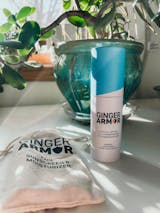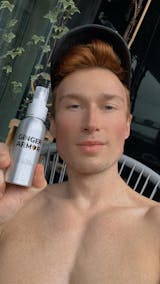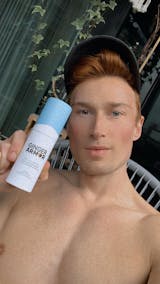Science Behind the Shield
Updated 2/15/2023
Sunscreens ending up in Your Bloodstream Citations:
Article BY KORIN MILLERPUBLISHED: JAN 25, 2020
https://www.prevention.com/health/a30645767/sunscreen-chemicals-bloodstream-fda-study/
FDA published on website
https://www.fda.gov/news-events/fda-voices/shedding-more-light-sunscreen-absorption
JAMA network
https://jamanetwork.com/journals/jama/fullarticle/2759002?guestAccessKey=81a4a1e1-66d2-4f85-8d80-8d4d1aa1c56e&utm_source=For_The_Media&utm_medium=referral&utm_campaign=ftm_links&utm_content=tfl&utm_term=012120
Technical Data of Clinical Trial
Trial Registration ClinicalTrials.gov Identifier: NCT03582215
all 6 of the tested active ingredients administered in 4 different sunscreen formulations were systemically absorbed and had plasma concentrations that surpassed the FDA threshold for potentially waiving some of the additional safety studies for sunscreens.
CosDNA.Com
Scientific overview of chemical and mineral sunscreen filters
https://pubmed.ncbi.nlm.nih.gov/6229554/
Bad Ingredients in many other sunscreens:
Male Specific -Testosterone issues:
“All three (chemical) sunscreens were detectable in urine... differences in testosterone levels were observed between the 2 weeks...serum estradiol and inhibin B (testosterone) levels were observed in men only.”
https://reader.elsevier.com/reader/sd/pii/S0022202X1530885X?token=DC0DC393B9CA7FBD4C8DB8AAA5536581E01F2B22EB692886BBE3F3527F86FD69D1E044CEB4FB8B4C73B50615C68040B2
“In an evaluation of CDC-collected exposure data for American children, researchers found that adolescent boys with higher oxybenzone measurements had significantly lower total testosterone levels (Scinicariello 2016).”
https://medshadow.org/ewg-trouble-sunscreen-chemicals/
“Since then, studies have shown a potential link between oxybenzone and lower testosterone levels in adolescent boys, hormone changes in men…”
https://www.cnn.com/2019/05/06/health/sunscreen-bloodstream-fda-study/index.html
“When adults applied a sunscreen formulation containing 10% (Oxybenzone) (Enzacamene) and (octinoxate) on a daily basis for a week, the mean urine concentrations for these was higher in men.”
https://reader.elsevier.com/reader/sd/pii/S0022202X1530885X?token=DC0DC393B9CA7FBD4C8DB8AAA5536581E01F2B22EB692886BBE3F3527F86FD69D1E044CEB4FB8B4C73B50615C68040B2
“In one epidemiological study, 2517 urine samples from United States (US) general population were analyzed for the presence of oxybenzone as part of the National Health and Nutrition Examination Survey, BP-3 (aka Oxybenzone) was detected in 97% of the samples…”
https://www.sciencedirect.com/science/article/pii/S2214750017300288#bib0095
Both women and men have these chemicals in them for over 24 hours after use. Per the study, the men held onto as much as double the amount of the chemicals tested compared to the females.
“In the present human study, we have demonstrated for the first time that the sunscreen compounds BP-3 (benzophenone), OMC (oxtinoxate), and 4-MBC (Enzacamene) were absorbed through the skin and excreted in urine.”
https://reader.elsevier.com/reader/sd/pii/S0022202X1530885X?token=DC0DC393B9CA7FBD4C8DB8AAA5536581E01F2B22EB692886BBE3F3527F86FD69D1E044CEB4FB8B4C73B50615C68040B2
“Homosalate is a potential endocrine disruptor and studies in cells suggest it may impact hormones. In addition to direct health concerns following homosalate exposure, the chemical may also enhance the absorption of pesticides in the body.”
https://www.safecosmetics.org/get-the-facts/chemicals-of-concern/homosalate/#:~:text=Homosalate%20is%20a%20widely%20used,skin%20care%20products%20with%20SPF.&text=Salicylates%20prevent%20direct%20skin%20exposure,increased%20risk%20of%20skin%20cancer.
Others:
Good (facts) Bad (facts) Unknown
all 6 of the tested active ingredients administered in 4 different sunscreen formulations were systemically absorbed and had plasma concentrations that surpassed the FDA threshold for potentially waiving some of the additional safety studies for sunscreens.
over a 21-day period, the researchers discovered that after the initial sunscreen application, the concentration of the six chemicals increased within the bloodstream each day it was applied, and stayed above FDA-mandated safety levels at day seven—which was after the study participants had stopped applying it. Not only that, levels of the ingredients homosalate and oxybenzone were still above safety thresholds on day 21.
The findings support those from a pilot study conducted by the FDA last year, which also found that four popular chemical sunscreen ingredients (avobenzone, oxybenzone, octocrylene, and ecamsule) were easily absorbed into the skin and went into the bloodstream after one day of use.
|
ClinicalTrials.gov Identifier: NCT03582215
|
|
Recruitment Status : Completed
First Posted : July 10, 2018
Results First Posted : April 21, 2020
Last Update Posted : April 21, 2020
|
Good Ingredients in Ginger Armor:
Sunscreens
Zinc Oxide (Non-Nano to keep the user and nature safe) is a mineral sunscreen and the only FDA approved sunscreen ingredient to cover both UVA & UVB sun rays.
Zinc oxide is a safe and effective ingredient in photoprotective products. It is photostable, nonphotoreactive,[19]
(Moloney FJ, Collins S, Murphy GM
Am J Clin Dermatol. 2002; 3(3):185-91.
Zinc oxide is nonphotocatalytic.[12] It has little potential for irritation or sensitization.
(Nash JF Dermatol Clin. 2006 Jan; 24(1):35-51.)
Titanium Dioxide is a mineral sunscreen covering UVB and partial UVA sun rays.
Titanium Dioxide 7.8%, Zinc Oxide (Non-Nano) 9.0%
“Titanium dioxide is a broad-spectrum UV filter that does not penetrate the stratum corneum.” (Reena Rai, Sekar C Shanmuga, and CR Srinivas 2012)
Moisturizers
Squalane mimics your skin's own moisture and keeps our skin's outer layer moisturized and protected. Our sebaceous glands naturally produce it and production declines in our 20s and 30s. Protects against damage from free radicals. Softens, hydrates and locks in moisture.
Origin: Our squalane is sourced from sugarcane*
Classifications:
https://thedermreview.com/squalane/
https://simpleskincarescience.com/squalene-squalane-oil-review-acne/
Argania Spinsosa (Argan) Oil nourishes, protects elasticity and reduces the appearance of fine lines and wrinkles.It’s benefits include: anti-aging, anti-inflammatory, antioxidative, moisturizing and anti-viral benefits.
Origin: Kernels of seed of Argania Spinosa plant.
Classifications:
https://www.theskincarechemist.com/glossary/argania-spinosa-argan-kernel-oil/
Vitis Vinifera (Grape) Seed Oil is an exceptionally strong moisturizer and antioxidant. Helps tighten the skin. High in linoleic and other fatty acids and helps with acne.
Origin: seeds of grapes from the plant Vitis vinifera
Classifications:
https://www.naturallyhonestlabs.com/post/grape-seed-oil
Helianthus Annuus (Sunflower) Seed Oil traps moisture and keeps skin well hydrated. It also helps prevent damage to cells by ultraviolet light and aids against premature aging of skin by protecting the collagen and elastin content.
Origin: seeds from sunflower
https://www.healthline.com/health/sunflower-oil-for-skin#takeaway
https://www.ncbi.nlm.nih.gov/pmc/articles/PMC5796020/
Carthamus Tinctorius (Safflower) Seed Oil has “high antioxidant effects and antimicrobial potentialities against several opportunistic skin pathogens. It seemed to act by bacteriostatic and bactericidal pathways as well as a strong antifungal growth inhibition.” (Oxid Med Cell Longev. 2020)
Olea Europaea (Olive) Oil has antioxidant and anti-inflammatory effects and is free radical fighting. Olive oil can penetrate the skin, prevent loss of moisture and give a silky smooth softness.
Origin: olives, fruit of olea europaea
Classifications:
https://www.healthline.com/nutrition/11-proven-benefits-of-olive-oil#TOC_TITLE_HDR_4
Carthamus Tinctorius (Safflower) Seed Oil is a lubricant for the skin surface, which gives the skin a smooth appearance. It is also used as a skin conditioning agent and is high in linoleic acid (aka omega 6 fatty acid) It is recommended for acne and is also good for reversing UV-induced hyperpigmentation (aka sun spots) in lab tests. One of Traditional Chinese Medicines' fundamental ingredients.
Origin: seeds of the Safflower plant
Classifications:
https://selfhacked.com/blog/safflower-oil/
Anti-Inflammatories Anit-oxidants
Rosmarinus Officinalis (Rosemary) Extract relieves skin inflammation and can soothe acne, eczema, and psoriasis. Rosemary Antioxidant protects cells against not only oxidation and inflammation but also against pathogens
Origin: ground dried rosemary leaves
Classifications:
https://www.mdpi.com/2079-9284/7/4/77
Bisabolol soothes inflammation. Having proven anti-inflammatory properties, bisabolol helps with acne, rashes, rosacea, psoriasis, and similar conditions associated with frequent skin irritations. It has also been shown that bisabolol calms the skin after exposure to UV rays, and tones down sunburns and redness.
Origin: Chamomile plant & bark of the Candeia tree of Brazil
Classifications:
https://incidecoder.com/ingredients/bisabolol
Oryza Sativa (Rice) Bran Extract absorbs UV light, is rich in essential fatty acids, and has antioxidant properties. Egyptians were known to use it to prevent their skin from tanning.
It’s also been proven to be an anti inflammatory.
Origin: outer layer of the rice plant known as the bran
Classifications:
https://www.sciencedirect.com/science/article/abs/pii/S0924224414001666
https://academic.oup.com/nutritionreviews/article/76/5/372/4925562
Tocopheryl Acetate (Vitamin E) has antioxidant and anti-inflammatory properties and is most commonly known for its benefits for skin health and appearance. It can be applied topically to your face to reduce inflammation and make your skin look younger.
|
Tocopherol (Vitamin E)
Antioxidants that are used in sunscreens and cosmetic products are vitamins and polyphenols. Vitamins formulated in sunscreens are water soluble vitamin C and lipophilic vitamin E. Application of L-ascorbic acid has shown to protect UV-related damage as measured by erythema or sun burn cells.[24]
Inhibition of ultraviolet light-induced erythema by antioxidants.
Roshchupkin DI, Pistsov MY, Potapenko AY
Arch Dermatol Res. 1979 Aug; 266(1):91-4.
Topical application of α-tocopherol has demonstrated a number of protective effects including reduction in erythema,[25] photoaging,[26] photocarcinogenesis,[26] and immunosuppression.[27]
|
Pongamia Glabra Seed (Karanja) Oil has antioxidant and emollient properties and is anti-inflammatory
Origin: Seed of Pongamia tree
Classifications:
https://www.researchgate.net/publication/313189324_ANTI-INFLAMMATORY_INVESTIGATION_OF_KARANJ-OIL_ISOLATED_FROM_PONGAMIA_PINNATA_SEEDS_IN_EXPERIMENTAL_ANIMAL_MODELS
Emolients
Stearic Acid has been shown to protect skin's surface against water loss and help shore up skin's protective barrier.
Coconut Alkanes is a volatile (something that does not absorb into the skin but evaporates from it), naturally derived vegetable alkane coming from renewable sources. It is a light, oily liquid that works as an emollient and gives a smooth skin feel.
Coco Caprylate/Caprate is a vegetable ingredient obtained from coconut. It presents a high level of biocompatibility with skin and therefore has the ability to penetrate deep and help skin to repair itself. It acts as an emollient and provides skin with incredible softness.
Caprylic/Capric Triglyceride creates a barrier on the skin's surface, which helps to reduce skin dryness by decreasing the loss of moisture.
Aids in making the sunscreen clear and lightweight
Alumina is an anti-caking agent: absorbing excess moisture by coating particles and making them water-repellent. It holds onto oils so they don't look shiny.
Polyhydroxystearic Acid is a commonly used dispersant for ultrafine titanium dioxide and zinc oxide. It renders the zinc oxide particles extremely hydrophobic and lipophilic, so that they are easily dispersed in esters, mineral oils and silicone fluids.
Terminology
Comedogenic
http://mosskincare.com/the-truth-about-comedogenic-ingredients-and-acne-prone-skin/
Video: dermatologists vary in what they consider comedogenic. Proof tests aren’t done in real life conditions. The most common test is the rabbit ear model, they apply the substance to the inside of a rabbits ear (because it’s much more sensitive than human skin) there were tons of false positives with this.
https://labmuffin.com/fact-check-how-to-use-comedogenicity-ratings/
https://www.healthline.com/health/non-comedogenic-oils#skin-effects
Nanomaterials are ultrafine single particles with a diameter less than 100 nm. (these can enter your bloodstream)
(Maynard A. Nanotechnology: A research strategy for addressing risk. Woodrow Wilson International Center for Scholars. 2006. Jun, [Last accessed 2007 Dec 1])
The adverse effects of nanoparticles include interface for catalytic reactions, complexes with proteins which can escape immunological surveillance, induction of autoimmune diseases
(Donaldson K, Stone V, Tran CL, Kreyling W, Borm PJ. Nanotoxicology. Occup Environ Med. 2004;61:727–8. )
Ginger Armor is ultra fine to keep it from being pasty, thick or white in appearance, but still 280 nm so it doesn’t risk ending up in your bloodstream (100nm or less is considered a nano particle)
Oxybenzone is not photostable and can generate oxygen radicals upon UV exposure.(Schallreuter KU, Wood JM, Farwell DW, Moore J, Edwards HG J Invest Dermatol. 1996 Mar; 106(3):583-6.)
There is a concern about its endocrine and carcinogenic effect even though current scientific studies have not supported this fears.
(Janjua NR, Mogensen B, Andersson AM, Petersen JH, Henriksen M, Skakkebaek NE, Wulf HC
J Invest Dermatol. 2004 Jul; 123(1):57-61.)
Avobenzone
Butyl methoxydibenzoylmethane or avobenzone provides superior protection through a large portion of the UVA range, including UVA I. Despite its efficacy and broad spectrum, avobenzone is intrinsically photounstable and significant photodegradation can occur with a loss of 50–90% of molecules after 1 hour of UV exposure.
(Photostability assessment of sunscreens. Benzylidene camphor and dibenzoylmethane derivatives. Deflandre A, Lang GInt J Cosmet Sci. 1988 Apr; 10(2):53-62.)
Tell me what you think? Copy and paste your findings to this so that I can learn and grow the formula to be better and better!
Ginger Armor Ingredients:
|
Titanium Dioxide
Zinc oxide
|
|
Carthamus Tinctorius (Safflower) Seed Oil
|
|
Coconut Alkanes: replacement (with Caprylic/Capric Triglyceride) for silicones
|
|
Coco Caprylate/Caprate: replacement (with Coconut Alkanes Triglyceride) for silicones
|
|
Caprylic/Capric Triglyceride
|
|
Stearic Acid
|
|
Alumina
|
|
Polyhydroxystearic Acid
|
|
Helianthus Annuus (Sunflower) Seed Oil
|
|
Pongamia Glabra Seed (Karanja) Oil
|
|
Vitis Vinifera (Grape) Seed Oil
|
|
Olea Europaea (Olive) Oil
|
|
Argania Spinsosa (Argan) Oil
|
|
Oryza Sativa (Rice) Bran Extract
|
|
Rosmarinus Officinalis (Rosemary) Extract
|
|
|
Argania Spinosa Kernel Oil
|
|
Tocopheryl Acetate (Vitamin E)
|
|
BisaboloL
|
|
*Squalane* From Sugarcane
|





